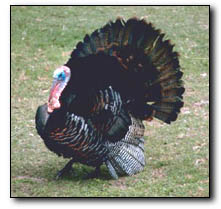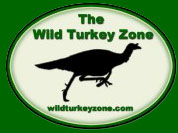|

Spring
Turkey Calling; Family Relationship and Social Status
By T.R. Michels, Trinity Mountain Outdoors
 During
my latest turkey seminar I began to realize that the
average hunter rarely thinks about how family relationship
and social status relate to the calls turkeys use
in the spring, or how understanding how these relationships
should affect which calls hunters use to call turkeys.
So, let's examine the makeup of spring turkey flocks. During
my latest turkey seminar I began to realize that the
average hunter rarely thinks about how family relationship
and social status relate to the calls turkeys use
in the spring, or how understanding how these relationships
should affect which calls hunters use to call turkeys.
So, let's examine the makeup of spring turkey flocks.
Many hunters may not realize that
the hen flocks they see in the spring or not just
a bunch of hens. What these flocks normally are made
up of is one or more adult hens with their year-old
female offspring. And the adult hens may also be related.
This means that much of the calling being done is
between the adult hen and her offspring, between the
offspring, and between the adult hens. It also means
that most of the birds in the flock know each other's
voices, particularly the hens and their own offspring.
Much of the calling hunters hear in the spring is
used to keep the families, and the flock together.
Many of these calls fall into the Social Contact and
Maternal/Neonatal Calls category.
Let's review some of these calls.
Hen "Family" Calls
The Yelp is often the first
sound of the day, a soft, nasal, three to five note
call performed while the birds are on the roost before
daylight. It is a soft chirp-chirp-chirp ... chirp-chirp-chirp-chirp,
or a variation. There are usually three to four notes
per second, with each note being about .08 seconds
in length. This call is used by a bird when it is
telling the others it is awake and asking if there
are other birds nearby and awake. In the case of spring
turkeys, it is often one of the female family members
asking if the other family members are still there.
I use this call in the morning to see if the birds
are still on the roost.
The Assembly Yelp is used by the hen to regroup
the young, and this probably carries over to some
extent in spring calling. This call usually consists
of six to ten or more evenly spaced yelps that are
loud and sharp, with two to four notes per second,
and each note lasting from .12 to .20 seconds. I often
hear hens make a loud, long series of yelps while
they are on the strut during the breeding phase. I
am not sure if this is an Assembly Yelp or a Lost
Yelp. But, I do know that toms often show up in areas
where hens are making this call. I use Lost Yelps
and Assembly Yelps to get a tom fired up on the roost,
and to keep it coming once it is on the ground.
The Lost Yelp is much like the Plain Yelp, but it
is often used by female offspring to locate their
mother in the spring, particularly after the hens
have been bred and begun nesting. When they return
to traditional feeding/strutting areas they often
try to regroup with each other. This may call contain
twenty or more notes, and it becomes louder toward
the end of the call. The bird's voice may "break"
as it tries to make the call as loud as possible,
which causes it to have a raspy sound. There may be
from three to four notes per second, with each note
lasting .10 to .15 seconds.
Hen
Flock Social Contact Calls
Adult turkeys use many different yelps
and clucks to keep in contact in different situations.
Most yelps are the same as the "Here I am, where
are you?" call of geese and other flocking birds,
which is used to keep the birds in contact with each
other. These calls are basically variations of the
hen "family" calls.
The Plain Yelp is performed
when turkeys are within seeing distance of each other.
It often consists of three to nine notes, all on the
same pitch and of the same volume, with three to four
notes per second, and each note lasting .08 to .10
seconds; chirp, chirp, chirp. I use this call when
toms are up close, or within seeing distance of the
decoys.
The Plain Cluck is used by
turkeys to get the visual attention of another bird.
It is primarily a close range contact call, again
saying "Here am I, where are you?" A bird
making this call wants to hear another bird make the
same call so they can get together. It is a sharp,
short sound, similar to the alarm putt but not as
loud or as insistent; tut...tut. The notes of the
cluck are often separated by as much as three seconds,
which distinguishes it from the faster, closely spaced
Fast Cutt. I often hear hens use several soft
Clucks and Purrs while they are feeding. It sounds
like putt, putt, putt, errr, putt .... putt, putt,
putt, errr. I use this call when a tom hangs up nearby,
or to stop it for a shot.
The Fast Cutt, or Cutting,
is one turkey using the "Here I am, where are
you?" but telling the other bird "If we
are going to get together you have to come to me."
It is a loud insistent call, and the notes are strung
together in bursts of two's and three's, with about
a second between bursts. It sounds like; TUT...TUT...TUT,
TUT. TUT .TUT, TUT...TUT...TUT, TUT...TUT... TUT,
TUT... TUT, or any variation of clucks. The rhythm
is somewhat like the Flying Cackle, and I have
used a Flying Cackle to get a tom to "shock
gobble." I also use this call to bring in a tom
that hangs up.
Male
Groups; Family and Social Contact Calls
Hunters may also not realize that
the males in a tom or jake group may also be related.
Since dominance, or social status, is often established
when the birds are growing up, and because there is
very little squabbling for social status between family
members (because social status is already established),
it is easy to see how male turkeys who are brothers
may stay together as long as the live. Again this
means they know the voices of each other. So, they
often use the same social contact calls the hens use,
except they generally have deeper voices. And because
they are males and do not separate to go off and lay
eggs, they rarely use the "family calls"
such as the Assembly Yelp and the Lost Yelp, or the
Fast Cluck. The may use Tree Yelps and Plain Yelps
to help them remain in contact with each other.
What this all boils down to is that
it is difficult for a hunter to convince a turkey
it is a member of its family or flock. However, this
doesn't mean calling won't work, because you can use
hen calls to call toms, and you can use aggressive
hen calls, such as a Fighting Purr, to call in hen
groups. What it does mean is that hunter should "think"
about what they are trying to simulate when they call,
and use the appropriate calls to accomplish their
task.
If you are interested in more turkey
hunting tips, or more biology and behavior, click
on Trinity Mountain Outdoor News and T.R.'s Hunting
Tips at www.TRMichels.com. If you have questions about
turkeys log on to the T.R.'s Tips message board.
This article contains excerpts from
the Turkey Addict's Manual ($19.95 + $5.00 S&H),
by T.R. Michels.
T.R. Michels is a nationally recognized
game researcher/wildlife behaviorist, outdoor writer
and speaker. He is the author of the Whitetail, Elk,
Duck & Goose, and Turkey Addict's Manuals. His
latest products are the 2003 Revised Edition of the
Whitetail Addict's Manual, the 2003 Revised Edition
of the Elk Addict's Manual; and the 2003 Revised Edition
of the Duck & Goose Addict's Manual.
For a catalog of books and other
hunting aids contact:
T.R. Michels, Trinity Mountain Outdoors,
PO Box 284, Wanamingo, MN 55983.
|

